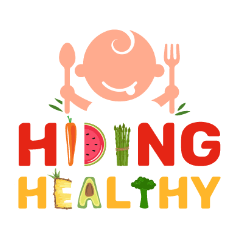Reducing Exposure to Toxins
One of my favorite topics to research and discuss with families is how to reduce exposure to toxins. This is super important, not just for children with autism but for everyone. There’s toxins in those convenient disinfectant wipes that I love so much, in the plastic containers where we store our food, in the shampoo we use, in the air we breathe, our water and food. Ugh…as if we didn’t have enough to worry about. 😩
What does the research say?
My goal with this blog isn’t to bum you out. It’s to show you how you can easily minimize toxins in your daily life. And maybe light a fire under your butt to make a few simple changes because this stuff is no joke. This topic is especially important for those with autism because they have a harder time ridding their body of toxins. There are many studies that link autism and neuroinflammation, which is inflammation of the brain and spinal cord. This may be caused by toxins that specifically impact the brain. What’s more, some studies have found that males are more negatively impacted by these neurotoxins. Does that sound familiar? Males are more often diagnosed with autism as well. I’m speculating but perhaps there is a connection here. One study goes so far as to say that we have a “global, silent pandemic of neurodevelopmental toxicity”. I plan to keep this post updated as I find more research on this topic.
The good news
Ok let’s move on to something positive. Lots of people are concerned about the effects that toxins can have on our children, our health and our environment. So there are plenty of resources out there to help us make good, informed choices about the products we buy and the companies we support. In this blog series I’ll provide you with practical tips and product recommendations for reducing toxins in:
- water
- food
- cookware, cooking utensils and food storage containers
- household products like candles, laundry detergent, hand sanitizer, cleaning sprays, deodorizers
- personal care products like soap, shampoo, lotion, anti-perspirants, nail polish, makeup and perfumes
- home improvement items like paint and yard maintenance like weed or pest-killers
- air purifiers and EMF remediation
- baby items like cribs, mattresses and toys
What does all this have to do with nutrition?
While I am a dietitian and my focus is on food, I know that nutrition is just one piece of the puzzle when it comes to health. Being in the health space, there are so many topics I come across and research to satisfy my own curiosity and to ensure I’m doing my best for my family. My blog is a way for me to share what I’ve found on these topics with you so you can benefit too and be well in all aspects of life!
Reducing toxins in your water
So let’s tackle water first – specifically drinking water!
What’s in our water that we have to worry about? Well, that depends on where you live.
The first step is to type your zip code into the Environmental Working Group (EWG) tap water database.
Click on your town or city. As you scroll down, you can see the contaminants that exceed the health guidelines. From here you can click on the details for each contaminant to get more information about the potential harm and the sources of pollution. EWG emphasizes that while many of the contaminants are within legal limits, those limits don’t necessarily correlate with public health. EWG has created their own health standards for drinking water which you can find here.
Click the “play” button below for a quick video guide!
Yikes. Hopefully your water profile looks a lot better than mine.
And if you’re anything like me you’re probably wondering “What the heck filter can I get my hands on that will take this junk out of my water?”😣
Filters to the rescue
There are a couple options here that I’ve looked into and trust.
The first option is the water filter that I own myself. The Berkey.
I love my Berkey so much I could run across an Austrian hillside and sing to the winds about it, Julie Andrews style. Why do I love it so much? Because with it, I don’t have to worry. I trust that those toxins in my drinking water are being filtered out. The Berkey removes bacteria, protozoa and viruses. This comes in especially handy if you have well water. Let me show you some pictures to give an example of what the Berkey can do. This is what my water looks like from time to time.
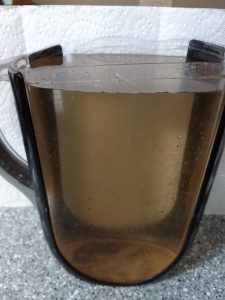
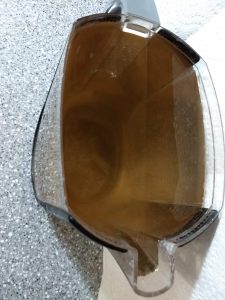
Yep, this came out of my kitchen faucet. I wish I could say this wasn’t a regular occurrence. The color could be due to a broken pipe in my town, hydrant flushing, who knows. The point is, drinking water shouldn’t be this color.
I poured this water straight into my Berkey.
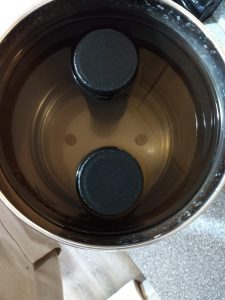
Yuck. Those cylinders are the black filters which remove all the toxins. You also have the option to add another set of filters which remove fluoride. Those filters sit in the bottom chamber.
Take a look at the filtration specs to see testing results and a big long list of all the contaminants that don’t stand a chance against the Berkey – heavy metals, VOCs and trihalomethanes to name a few, all of which are in my tap water.
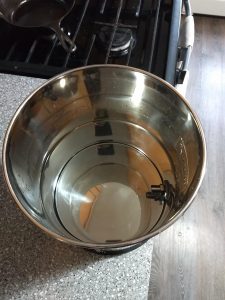
And here we have the finished product. The water is totally clear! Thank you sweet, wonderful Berkey.
A few minor downsides
I will say there are a few inconveniences about the Berkey. None of these have made me regret my purchase at all, but I did want to mention them in case it is helpful for you.
- The Berkey does take up a fair bit of counter space. We keep ours near the kitchen table on top of a buffet and this seems to workout well for easy access.
- The number of times you have to fill your Berkey each day depends on the size you have and how much water your family drinks. We have the Big Berkey, which holds about 2.25 gallons and we fill it about twice a day. The Berkey doesn’t fit under the faucet of our sink so we use an old Brita pitcher, fill it with water from the tap and pour that into the Berkey.
- The black filters should be replaced every 3000 gallons (or 6000 gallons for 2 filters) and if you have fluoride filters, those should be replaced every 1,000 gallons (or 2,000 for 2 filters). For us this amounts replacing the black filters once every 4 years and the fluoride filters every year and a half.
- The stainless steel chambers of the Berkey do need to be cleaned every so often. We clean ours once every couple months I’d say. I believe the company recommends cleaning once a month. The black filters should be cleaned with a rough sponge and just water, every 6 months or so.
- The Berkey is pricey. I paid about $350 for mine. I consider it some of the best money I’ve ever spent.
If you’re in the market for a Berkey, the Hercules of water filters, check out these cost-saving bundles or take a look at all of their products here.
I want to mention another water filtration company that has caught my attention recently and that is Clearly Filtered. They offer a range of products including pitchers and undersink systems. They even have a universal refrigerator insert which seems super convenient. Berkey actually offers comparisons of their products with top competitors. Berkey’s smallest “travel” system is most comparable to the Clearly Filtered water pitcher. The two are similar in terms of what contaminants they filter out. In the short term, Clearly Filtered has the advantage but if you’re going for long term cost savings, Berkey definitely wins out with a cost of just .04¢ per gallon vs .45¢ per gallon with Clearly Filtered. I haven’t purchased anything from this company myself but I appreciate the transparency, they make testing results available for each of their products.
Ok that’s a wrap for drinking water! Next up, I’ll focus on shower and bath water so stay tuned. To stay up to date on my latest blog posts, connect with me on Instagram @elisarocksrdn!
Just a heads up – some of my blogs contain affiliate links. If you buy something through one of these links, you don’t pay more but I do get a small commission, which helps support my business so I can provide you with more useful content. Thank you!



